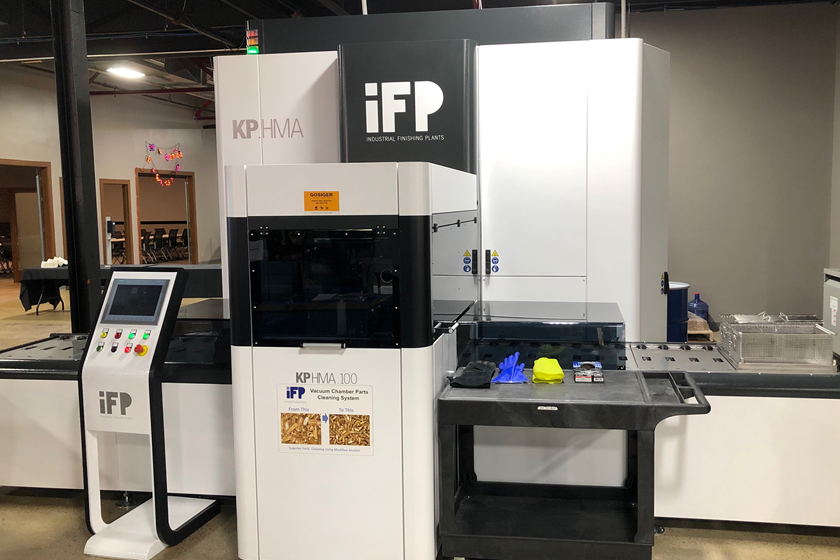Laser Engraving Anodized Aluminum
Question: We have an issue with a 30-watt CO2 laser engraver that we are using to mark our aluminum parts.
Question:
We have an issue with a 30-watt CO2 laser engraver that we are using to mark our aluminum parts. The parts are Type II anodize in either clear or black. Some in our company believe that at least a 0.5 mil anodic coating is required for the laser to make a mark that can been seen. If a part does not mark, it is being blamed on the coating thickness. We have anodized parts as long as 50 minutes and we still get variability in the markings. I believe the variation is due to the laser itself. Would the variation in the quality of the mark we make be affected more likely by the coating thickness or by the laser? Should we have a stronger laser? We don’t want to cut all the way to raw aluminum when we mark as corrosion is an issue. DP.
Answer:
This question is of particular interest to me because I used to have Space Station parts laser engraved after we anodized them in the mid 1990s. I enlisted my friend, Ted Sewall at Laserscribe, Inc. in Indianapolis to help with this question. He used to do the laser engraving on those parts. He explains that there are two types of lasers that are used for etching or scribing (laser engraving) metal surfaces. One is called a YAG (for Yttrium, Aluminum, Garnet). This is a crystalline, solid state laser that emits a laser at wavelength 1.064 micrometers (1064 nanometers). This type of laser is capable of scribing right through the anodic coating to the bare substrate below. Turning the power to maximum will determine how deep the engraving is and how rough it leaves the metallic surface. I personally know of anodic coatings up to 2.0 mils (50 micrometers) in thickness that are successfully engraved in this manner. Of course, the anodic coating is actually removed in this process. By operating on a very low power setting the YAG laser is capable of removing “color” from an anodic coating without removing the coating. This only has viability for darker colored coatings.
Featured Content
The other type laser engraver uses a combination of gasses (carbon dioxide, nitrogen and helium) to emit a wavelength of light (10.6 micrometers) that is the same as that of aluminum. Thus, the aluminum is reflective of this wavelength laser beam. The engraving mechanism, then, is to absorb dark colors present in the anodic coating. No anodic coating is actually removed. The rate of absorption of the color from the anodic coating is determined by the anodic coating thickness, more quickly absorbed in thinner coatings, less quickly in thicker coatings. So, if you had a black anodized coating, for instance, the laser absorbs the black color leaving the “white engraved” anodic surface. If the coating is clear anodized, the engraved results may be a mixed bag. With clear anodic coatings the depth of “color” (usually shades of gray) is dependent on both the alloy and temper of the part being engraved as well as being dependent on the anodic coating thickness. The more coating thickness normally the darker the “clear” color.
I think what you may be seeing is when the coating thickness is roughly less than 0.5 mil there is not enough color in the coating to enable you to see that color is being absorbed by the laser. As the coating gets thicker, there is more apparent color and the laser can now do its job (to the eye) of absorbing color. You might try engraving samples of different coating thicknesses and also a dark color such as black, blue, green or red and you will see that the etching or engraving works well at any coating thickness if the coating is dark enough for the laser to be able to absorb enough color from the coating that your eye can detect the difference.
I hope that helps. I would be very interested in any experimental results you can tell me about when you try this.
RELATED CONTENT
-
Fixing Corrosion Between Anodized Aluminum and Steel
Anne Deacon Juhl, Ph.D., with AluConsult, says Galvanic corrosion is due to an electrical contact with a more noble metal or a nonmetallic conductor in a conductive environment.
-
Preventing Anodizing Cathodes from Turning Red
While the red color may not be desirable, anodizing expert Drew Nosti says it poses no particular problem to a successful anodizing process.
-
What is the Correct Anodizing Specification?
My company fabricates aluminum and steel pedestrian bridge railing among other bridge parts. We recently got an aluminum railing job that called for “Type I” anodizing per MIL-A-8625. There was no anodic coating thickness called out. We are not anodizers and we are at a loss as to how to write up a meaningful anodizing specification for this railing.



















